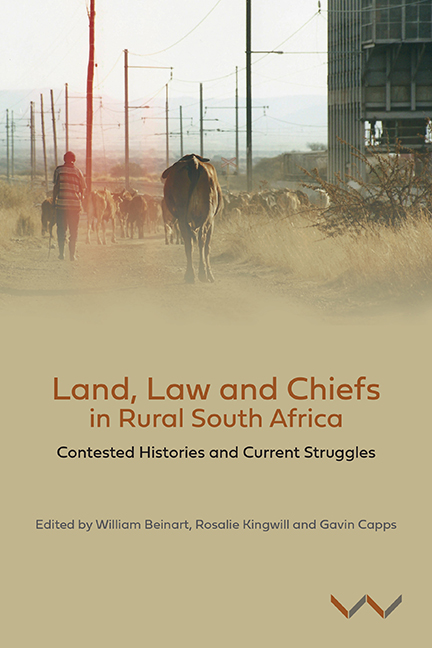Book contents
- Frontmatter
- Contents
- Maps
- Acronyms and Abbreviations
- Preface
- Introduction Land, Law and Chiefs: Contested Histories and Current Struggles
- Chapter 1 Constitutional Court Judgments, Customary Law and Democratisation in South Africa
- Chapter 2 Was ‘Living Customary Law’ There All Along?
- Chapter 3 When Custom Divides ‘Community’: Legal Battles over Platinum in North West Province
- Chapter 4 Chiefs, Mines and the State in the Platinum Belt: The Bapo-ba-Mogale Traditional Community and Lonmin
- Chapter 5 Mining, Graves and Dispossession in Mpumalanga
- Chapter 6 The Abuse of Interdicts by Traditional Leaders in South Africa
- Chapter 7 Resisting the Imposition of Ubukhosi: Contested Authority-Making in the Former Ciskei
- Chapter 8 Black Landlords, Their Tenants and the Native Administration Act of 1927
- Chapter 9 Customary Law and Landownership in the Eastern Cape
- Chapter 10 A History of Communal Property Associations in South Africa
- Chapter 11 ‘This is Business Land’: The Hlolweni Land Claim, 1983–2016
- Chapter 12 Restitution and Land Rights in the Eastern Cape: The Hlolweni, Mgungundlovu and Xolobeni Cases
- Contributors
- Index
Chapter 11 - ‘This is Business Land’: The Hlolweni Land Claim, 1983–2016
Published online by Cambridge University Press: 15 June 2021
- Frontmatter
- Contents
- Maps
- Acronyms and Abbreviations
- Preface
- Introduction Land, Law and Chiefs: Contested Histories and Current Struggles
- Chapter 1 Constitutional Court Judgments, Customary Law and Democratisation in South Africa
- Chapter 2 Was ‘Living Customary Law’ There All Along?
- Chapter 3 When Custom Divides ‘Community’: Legal Battles over Platinum in North West Province
- Chapter 4 Chiefs, Mines and the State in the Platinum Belt: The Bapo-ba-Mogale Traditional Community and Lonmin
- Chapter 5 Mining, Graves and Dispossession in Mpumalanga
- Chapter 6 The Abuse of Interdicts by Traditional Leaders in South Africa
- Chapter 7 Resisting the Imposition of Ubukhosi: Contested Authority-Making in the Former Ciskei
- Chapter 8 Black Landlords, Their Tenants and the Native Administration Act of 1927
- Chapter 9 Customary Law and Landownership in the Eastern Cape
- Chapter 10 A History of Communal Property Associations in South Africa
- Chapter 11 ‘This is Business Land’: The Hlolweni Land Claim, 1983–2016
- Chapter 12 Restitution and Land Rights in the Eastern Cape: The Hlolweni, Mgungundlovu and Xolobeni Cases
- Contributors
- Index
Summary
The ‘land question’ remains at the centre of South African political discourse. Land restitution has been an important strategy for addressing racially unequal ownership of land as well as forced removals in the apartheid era. This chapter focuses on the Hlolweni (2003) land claim, made by 883 families from three poor, rural communities in the Eastern Transkei (Mpondoland) – the villages of Mfolozi, Etyeni and Hlolweni. Starting in 1983, these families were forcefully removed from about 10 000 ha to make way for a sugar cane plantation and outgrower scheme. The families brought a restitution claim to the Eastern Cape office of the Land Claims Commission in 1995, which eventually came to court in 2009. By this time the Eastern Cape government, which controlled the land, had agreed to the claim but the claimants were opposed in court by three associations of black smallholder farmers who had been beneficiaries of the scheme. The claimants secured a favourable judgment in 2010.
A historical study of this land claim is significant for two principal reasons. Firstly, it highlights important challenges in settling restitution claims on land in the former Bantustans (homelands), particularly when the chosen legal vehicle to hold the restituted land is a communal property association (CPA – see Weinberg in this volume). Secondly, the claim is significant from a broader historiographical point of view, in that it informs our understanding of how African ‘communal tenure’ has evolved over time. The central argument in this chapter is that wider economic and political forces affect how people perceive rights to a particular plot of land, and that these perceptions can change over time. The Hlolweni claim is an instructive case study because, during the period assessed here, three distinct understandings of how a piece of land may be used have evolved amongst the same group of people. This is an important argument, as much of the existing literature posits ideas of customary or communal tenure that are too static.
The question of who ‘owns’ land in the former homelands has been deeply contested historically. For much of the colonial and apartheid era, officials referred to the system of occupation in these areas as ‘communal’ or ‘customary’ tenure. Sydney H. Fazan, a Kenyan official writing on the Transkei during the 1940s, cites a number of magistrates claiming that codified systems of land administration were designed ‘to copy Native custom’ (Fazan 1944: 46–47).
- Type
- Chapter
- Information
- Land, Law and Chiefs in Rural South AfricaContested histories and current struggles, pp. 229 - 246Publisher: Wits University PressPrint publication year: 2021

